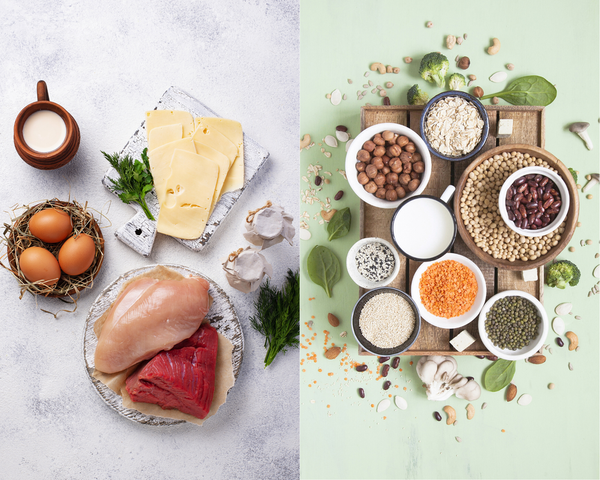What does the science say about protein? If you asked the average person where they would expect to get their protein from, they would likely say meat, dairy, eggs and fish. At a sporting level, muscle growth and repair has always considered to be maximised by animal protein. But in recent years, more information has come to light about the protein content of plant foods - and all of the other beneficial compounds that come along for the ride. So how do animal and plant proteins stack up against each other?
The protein package
Society has positioned foods in a way that makes us obsess over individual macronutrients (protein, carbohydrates, fat). But food is much more than that, and the protein content is a small portion of what food can offer to us.
Let's look at 100g of beef; we get an array of B vitamins, high protein and amino acid content, and good levels of minerals such as zinc and selenium. But what about everything else that comes with it?
The majority of farmed meat and poultry sees animals farmed in shocking conditions. This leads to them being prone to disease, and as a result fed large amounts of antibiotics to counter this. A report showed that 281 tonnes of ionophore antibiotics were sold in the UK in 2017 to combat cocciodiosis (1) - an intestinal disease contracted by chickens from eating chicken droppings. Such foods are bound to create a possible window for ill health in humans who consume large amounts.

Red meat has had many studies conducted on it over the years. Whilst there are numerous vitamins and minerals present that can benefit human health, excessive consumption has been linked to many chronic diseases we see today.
A 2016 meta-analysis (2) showed that high consumption of red meat, especially processed meat, is linked with a higher incidence of cardiovascular disease. The same meta-analysis also showed that increased plant protein intake (from beans, legumes, grains etc) resulted in a lower all-cause mortality and cardiovascular disease risk.
Plant protein is abundant in a wide variety of plant foods as mentioned; beans, legumes, grains, tofu and tempeh being prime examples. Where plant foods differ from animal foods is that they contain phytonutrients and fibre - which animal foods don't. Phytonutrients are a wide range of beneficial plant compounds which can help to prevent disease, and regulate bodily functions.
Fibre is especially important for regulating digestive function; short chain fatty acids (butyrate, propionate and acetate) are produced by the fermentation of fiber in the colon, and they can have anti-inflammatory effects on the gut and aid in the treatment and prevention of digestive issues such as inflammatory bowel disease (3). They also have a positive in regulating metabolism, inflammation and disease (4), further showing the benefit of fibre in high-protein plant foods.

Amino acid profile
Plant protein has received a bad rap for not possessing a complete essential amino acid profile. This owes to the incorrect findings of biochemist Karl Heinrich Ritthausen in the 1900's. He claimed that plant proteins were incomplete (5) and were missing essential amino acids; information that continued to be peddled for a number of years.
American physican Dr John McDougall provided a response (6) to the American Heart Association, categorically stating that it was incorrect. The fact is, all plant foods contain all the essential amino acids that our body cannot produce - in varying amounts. Eating a diverse range of high-protein plant foods is the single easiest way to get all the required protein; shoot for a mix of beans, legumes, unrefined grains to cover your needs.
It is clear that from a health perspective, there is value in adding more plant protein to one's diet. Large-scale studies have shown the drawbacks of excessive animal protein on human health. With the adverse effects of animal protein consumption now known, how do we combat it? A shift must be made to incorporate more plant-based protein into our diets.
Nutritional education is also important from a health perspective; it is a good starting point to know which foods you can replace animal products with, so you don't encounter any nutritional deficiencies. Having said that, the resources available are in abundance, showing how to incorporate more plants in a smart and healthful manner.
References:
1) https://www.independent.co.uk/news/uk/home-news/antibiotics-chicken-uk-farms-drug-resistance-poultry-countryfile-a8847326.html - Tonnes of antibiotics still used in UK chicken farms
2) https://jamanetwork.com/journals/jamainternalmedicine/fullarticle/2540540 - Association of Animal and Plant Protein Intake With All-Cause and Cause-Specific Mortality
(3) https://www.ncbi.nlm.nih.gov/pubmed/12769445 - Increasing fecal butyrate in ulcerative colitis patients by diet: controlled pilot study
(4) https://www.ncbi.nlm.nih.gov/pubmed/24388214 - The role of short-chain fatty acids in health and disease
(5) Vegetarian Protein Is Just As 'Complete' As Meat, Despite What We've Been Taught
https://www.huffingtonpost.co.uk/entry/vegetarian-protein-complete-meat_n_5a90357ae4b01e9e56bb3224?guccounter=1&guce_referrer=aHR0cHM6Ly9jb25zZW50LnlhaG9vLmNvbS8&guce_referrer_sig=AQAAAFt3JXGUlmGSeOG8VBlVKMjdcBorSQb8BkD8AUApj-vPJ3dqOMfrf20NVoLxskJAu6fAtWJ9-aI0CPjcfWY2_m-hZWFYF0Vn-qv7VVfLuSc3LBLZnvxt91oIPUb96DnCTuUbwetUFGSGgiYbsULparZmbox3eL424n61xegCvaS6
(6) https://www.ahajournals.org/doi/pdf/10.1161/01.CIR.0000018905.97677.1F - Plant foods have a complete amino acid composition
